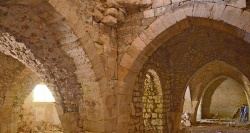Remains of ancient Christian hospital discovered in Jerusalem

A recent finding in the Old City of Jerusalem has unearthed the ruins of what is now considered to be the Order of St John’s first hospital, dating back more than 900 years.
“This was where the members of the St John’s Hospital order lived. This is where it started. This was the first place where they used an ambulatory service to bring in sick and wounded people to the hospital. They had riders on camels and horses” said Amit Re’em, excavation co-director for the Israel Antiquities Authority. The hospital is the largest of its era to be discovered in the Middle East region.
The exciting discovery has revealed details of the probable size of the building, a busy hospital dating back to the period between 1099 and 1291. The building is situated in the heart of the Christian Quarter in the Old City of Jerusalem, near David Street, the main road in the Old City.
The works, authorized by the Israel Antiquities Authority, expose parts of a structure which seems to extend across a large area. It is more than six meters high and reveals a great hall composed of pillars and ribbed vaults, rooms and smaller halls.
Contemporary historical documents, most of which are in Latin, mention a sophisticated hospital that was as large and as organized as a modern hospital. The Israeli Authority, in presenting the exciting findings, commented that: “The hospital was established and constructed by the Order of St. John of the Hospital in Jerusalem and known by its Latin name the Hospitallers (from the word hospital). They took an oath to care for and watch over pilgrims, and when necessary they joined the ranks of the fighters as an elite protective unit.”
The findings and the early sources provide considerable detail, much of which we already know: the hospital was dedicated to John the Baptist, and treated people of all faiths passing through Jerusalem. It had different wings and departments depending on the nature of the illness and the condition of the patient – similar to the arrangements in a modern hospital. In an emergency the hospital could accept as many as 2,000 patients. Our Hospitallers treated sick men and women of different religions with respect, no matter who they were nor from where they came from. The Muslim Arab population was pivotal in assisting the knights of St. John in establishing the hospital and teaching them medical science. Arab culture has always held the medical profession in high regard and Arab physicians were famous far and wide.
The sources also note that, in addition to the medical departments, the hospital also functioned as an orphanage where abandoned newborns were brought.
In the Middle Ages parts of the structure were used as a stable and the bones of horses and camels have been found in the excavations, alongside a great deal of metal used for shoeing the animals. In 1457, the building collapsed in an earthquake and was buried.
The discovery was prompted by a planning permission requested by the Grand Bazaar Company of East Jerusalem to create a restaurant. They worked in cooperation with the Israel Antiquities Authority to carry out the excavations prior to the start of the new works. Building project manager Monser Shwieki said developers intend to incorporate the building into the planned restaurant. The site will be open to the public sometime in 2014.
Source: Order of Malta


















